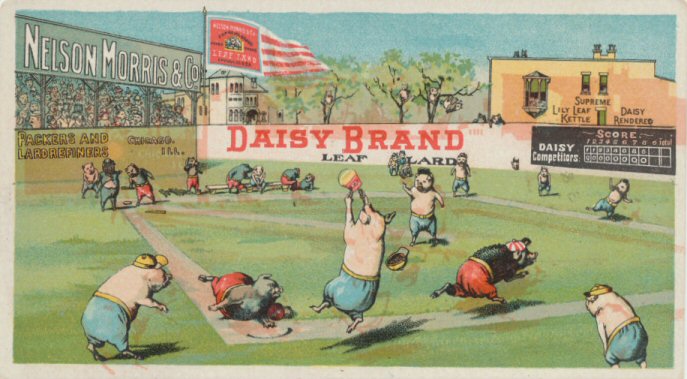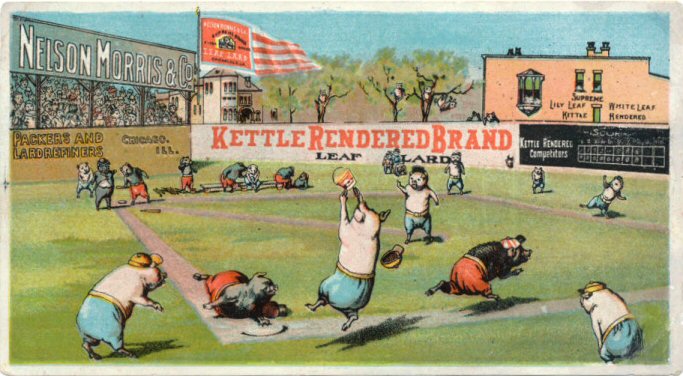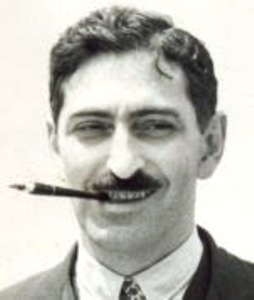2. Set Profile: 1890s "Pigs Play Baseball" Trade Cards
These "Pigs Play Baseball" trade cards were originally distributed in the 1890s by Nelson Morris & Company of Chicago. They feature a game in progress complete with a filled stadium in the background at left under a large sign and flag promoting the Nelson Morris meat packing company. Curiously, the products being promoted on the cards are the company's several brands of cooking lard, a key by-product of pigs.
The cards measure 3-3/8 by 6-1/4 inchs and are printed in full color. Visible fencing behind the third base line promotes one of five Nelson Morris brands of lard. A scoreboard on the right side of the card shows that after eight innings of play the home team is leading its "Competitors" by a score of 31 to 0! An example card promoting the company's Daisy Brand Lard is shown below.
The Nelson Morris cards are cataloged by veteran baseball trade card collector Frank Keetz as H804-208. The H804 reference is rooted in the trade card section of the American Card Catalog for "Baseball Comics." Keetz has expanded on this reference to include a group of "single cards without titles." The "Pigs Play Baseball" cards are #208 within that group.

Daisy Brand |
The Nelson Morris cards are scarce but not too difficult to find with a little patience, as several seem to show up every year on eBay or other auctions.
Many collectors are unaware, however, of some of the more obscure variations of the cards. Altogether, five different Nelson Morris brands are known to be printed on the fence behind the third base line on the front of the cards, and some of these are very rare. The five brands include: Daisy, Supreme, Kettle Rendered, Lily Leaf and White Leaf. In addition to the "Daisy" example shown above, the additional four brands are illustrated here:

White Leaf Brand |

Supreme Brand |

Lily Leaf Brand |

Kettle Rendered Brand |
Of these variations, cards displaying the Daisy, White Leaf and Supreme brands are perhaps the most difficult to find. They are not listed in the third and final edition of Frank Keetz' definitive book "Baseball Advertising Trade Cards" published in 2011. Cards for Lily Leaf and Kettle Rendered brands are listed in Keetz book.

H804-208 Card Backs
(click to enlarge) |
|
All of the card backs (see example at left) display the same message, which is basically a price list for various quantities of several of the Nelson Morris products.
The lard brands identified on the card backs vary a little from the five brand variations printed on the card fronts. Thus, "Old Fashion" and "Purity" brands are listed on the backs while "Daisy" brand is not.
It is also interesting to note that all lard was sold in units of "tierces," a measure of volume virtually unheard of today. One tierce is equivalent to about 42 US gallons, or about 340 pounds of lard.
A date and the prices for a tierce of lard were to be hand written on the backs of the cards (blank in this example). Pricing for smaller packages are shown as a surcharge (add on) to the price for a tierce, and are typeset and printed on the cards.
| |

Nelson Morris |
German-born Nelson Morris, the company's founder, arrived in Chicago in 1854 and began working with meatpacker John B. Sherman. Morris started packing under his own name in 1859.
During the Civil War, he sold cattle to the Union armies. Morris's company was one of the original meatpacking companies at the city's Union Stock Yard, which opened in 1865.
By 1873, the company's annual sales were about $11 million. Like other leading Chicago packers such as Swift and Armour, Morris's operations extended across the nation during the last decades of the nineteenth century. The company owned packing plants in East St. Louis and Kansas City, as well as cattle ranches in Texas and the Dakotas. The Morris-owned Fairbank Canning Co. slaughtered more than 500,000 cattle a year by the beginning of the 1890s.
At the start of the twentieth century, Nelson Morris & Co. had nearly 100 branches across the United States and employed over 3,700 people at the Union Stock Yard. By the time the founder died in 1907, annual sales had reached about $100 million. Still a leading American food company at the end of the 1910s, it was merged into Armour & Co. in 1923.


